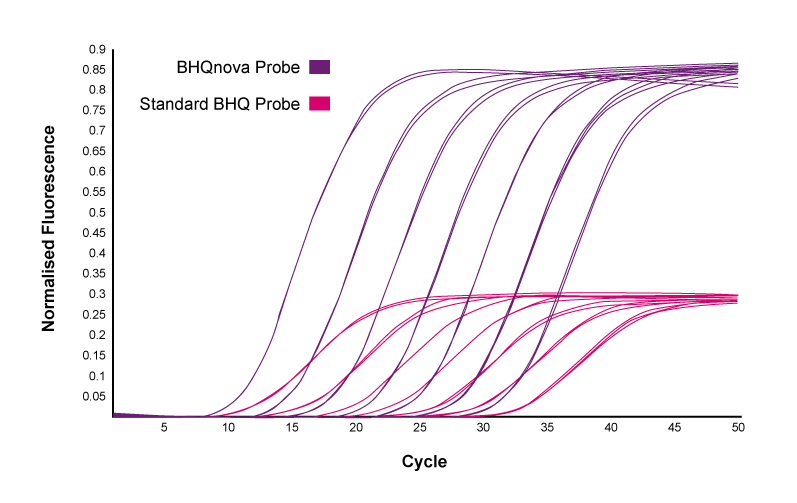Originally published : Wed, April 9, 2025 @ 10:16 PM
Getting multiple qPCR results at the same time in the same well is extremely valuable for assay developers. The time and cost saving of multiplexing is what makes it a popular choice when probing for several targets in a sample.
However, this increase in information from each assay means that there is even greater need for high sensitivity and specificity to avoid spurious results. If you are using a hydrolysis probe, the quencher dye used is an important factor that can profoundly influence the performance of a multiplex qPCR assay.

Choosing a quencher with high efficiency
High quenching efficiency is essential to reducing the risk of background fluorescence during your assay. Ideally, the quencher should completely suppress the fluorescence of the probe dye until the probe is hydrolysed, at which point the quencher is separated from the dye and the signal can be detected clearly. However some quenchers, such as TAMRA, emit their own light that contributes to increased background noise.
Black Hole Quenchers (BHQ®) are true dark quenchers, which take advantage of two separate mechanisms to quench fluorescence to a much higher degree. For more details on these, see our Quenching mechanisms page. BHQ does not emit any radiation and so by reducing the noise caused by background fluorescence, the true signal from the assay will be clearer to detect and quantify.
Matching the right quencher with probe dyes
When selecting dyes for a multiplex assay, it is essential that their fluorescence emissions don’t overlap significantly. If this happens, the signal from one probe can be interpreted as coming from another, known as cross-talk. With each dye covering a different part of the emission spectrum, the quenchers used must also be wide-ranging.
There are several BHQ dyes available to quench different wavelengths:
|
Dye |
Effective quenching |
5’ Mod. |
3’ Mod. |
Internal |
|
BHQ-0 |
430-520 nm |
✔ |
✔ |
|
|
BHQ-1 |
480-580 nm |
✔ |
✔ |
✔ |
|
T(BHQ-1) |
480-580 nm |
✔ |
|
✔ |
|
BHQ-2 |
559-670 nm |
✔ |
✔ |
✔ |
|
T(BHQ-2) |
559-670 nm |
✔ |
|
✔ |
|
BHQ-3 |
620-730 nm |
✔ |
✔ |
✔ |
The absorption spectra of the BHQ dyes can be seen below. However, it is important to consult a dye selection chart for details of which BHQ pairs best with each dye. The static quenching mechanism of BHQ dyes means that they can be effective beyond what would be expected from simply looking at the spectral overlap between dye and quencher. For example, our Quasar® 670 and Quasar 705 dyes might appear to match best with BHQ-3, peaking at 670 nm and 705 nm respectively, however BHQ-2 actually provides the best performance for these long wavelength dyes.

Quenchers to suit a range of probe structures
When designing a multiplex assay, the probes should typically be between 20 and 30 bases long. In addition, the probes should have a melting temperature that is 5-10 °C higher than the primers to ensure that a high percentage of target sites are bound.
For most probes, the standard BHQ probe design should work sufficiently. If other practical considerations require a probe shorter than 17 bases, consider ordering this sequence as a BHQplus® Probe. These probes incorporate duplex-stabilising chemistry to enhance sequence specificity and permit the design of shorter probes. The modified C and T nucleotides of BHQplus Probes can also improve performance in mismatch discrimination and binding to difficult regions, like AT-rich targets.
Alternatively, probes with locked nucleic acids (LNAs) are also compatible with BHQ and allow for shorter probe lengths. LNAs fix the conformation of the ribose ring into a more favourable structure for hybridisation. Each LNA increases the Tm of the probe-target duplex by 2-8 °C, and up to seven LNAs can be incorporated in a probe.
A minor groove binder (MGB) moiety can also improve binding for short probes. Up to two MGB probes can used in multiplex assays with sequences as short as 12 bases. These are available with Eclipse Dark Quencher, rather than BHQ, but the short length of the probe means that they are quenched effectively with high signal to noise ratios.
 If your target requires a probe longer than 30 bases, this will reduce the quenching efficiency as the dye and quencher are separated. In these cases, consider ordering a BHQnova® Probe, which has an internal nova quencher between bases 9 and 10. These double-quenched probes have lower background fluorescence and provide improved assay sensitivity in multiplex reactions.
If your target requires a probe longer than 30 bases, this will reduce the quenching efficiency as the dye and quencher are separated. In these cases, consider ordering a BHQnova® Probe, which has an internal nova quencher between bases 9 and 10. These double-quenched probes have lower background fluorescence and provide improved assay sensitivity in multiplex reactions.
BHQnova can also be used with more traditional probe lengths, making them a popular choice for multiplex assays. They can increase the sensitivity by reducing background fluorescence that causes cross-talk between detection channels.

qPCR amplification curves comparing a BHQnova probe (purple) and a standard end-labelled probe (pink) of the same 35-base sequence.
Example use cases of BHQ for multiplex assays
BHQnova Probes have been used in the CDC’s Flu SC2 Multiplex Assay which detects and distinguishes between influenza A, influenza B and SARS-CoV-2 viruses.1 This allowed laboratories to run more tests, conserve testing materials and provide valuable surveillance information on the diseases to public health officials.
BHQplus Probes have been used to create a multiplex qRT-PCR assay as a lung cancer diagnostic test. The shorter probes allow for targeting challenging sites without losing performance.
BHQ can also be used in molecular beacons, which have a high sensitivity to single nucleotide variations. This has been used to develop multiplex assays that discriminate against COVID-19 variants.2
Delivering reliable results for multiplex assays
For the past 25 years, BHQ has served as the quencher of choice for qPCR probes. Thanks to its reduced background fluorescence, BHQ offers clearer results for multiplex assays. With a wide range of options available, it is straightforward to find a suitable quencher to match your chosen dyes and probe designs.

|
To learn more about optimising your multiplex assays, download our latest ebook. 
|
References
- CDC’s Influenza SARS-CoV-2 Multiplex Assay https://www.cdc.gov/flu/php/laboratories/influenza-sars-cov-2-multiplex-assay.html Accessed 14 January 2025.
- Dikdan RJ et al. (2022) Multiplex PCR Assays for Identifying all Major Severe Acute Respiratory Syndrome Coronavirus 2 Variants. J Mol Diagn 24(4):309–319. doi: 1016/j.jmoldx.2022.01.004

